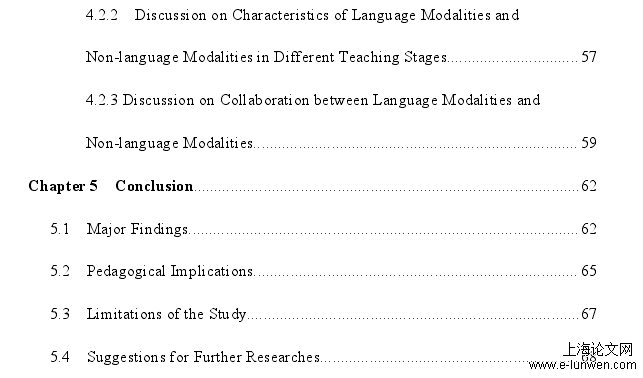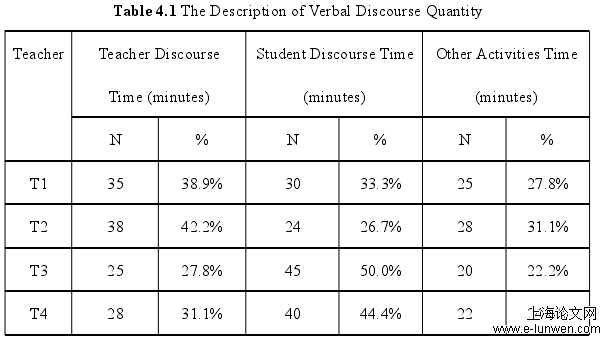Chapter 1 Introduction
2.1 Multimodal Discourse Analysis (MDA)
In recent years, with the development of discourse analysis, a group of scholarshave begun to turn their attention to all communicative symbols to explore the role ofvarious symbols in discourse and the relationship between them in the process ofcommunication. Therefore, discourse analysis has opened a new window ---multimodal discourse analysis.
2.1.1 The Definition of Mode, Medium, Modality, Multimodality
In multimodal discourse analysis, mode, medium, modality and multimodalityare several important concepts that often appear, and they are closely related to eachother. These concepts will be discussed separately for better understanding in thefollowing part.
Mode is the “semiotic resource which allows the simultaneous realization ofdiscourses and types of interaction”. Media, on the other hand, is defined as “thematerial resources used in the production of semiotic products and events, including both the tools and materials used” ( Kress & Van Leeuwen, 2001:21-22). From theirdefinition, the difference between the two concepts can be seen --- “mode” is“content” and “medium” is “expression”. Norris also agreed that mode is a semioticresource, but opposed to make its concept concrete. Norris (2004:152) claimed “amode is a loose concept of a grouping of signs that have acquired meaning in ourhistorical development. We need to realize that modes can be defined quite differently.For example, what I have called the mode of print can also be divided into the modeof images and the written word, or into a range of other equally correctcommunicative modes”. Therefore, mode is an open, heuristic concept, an analyticaltool, and a way of looking at a text from the constituent elements of a text. There arealso some domestic scholars’ research involving these two concepts. Professor HuZhuanglin (2007:2), a famous linguistics professor in China, also believed that“mode” is a comparable and opposite symbol system, and “medium” is a materialmeans of symbol distribution. There is an inherent connection between the two. Inaddition, professor Zhu Yongsheng (2007:83) believed that “mode” is one of the threeelements of context --- “mode of discourse”, which means communication channels,such as spoken mode, written mode and electronic mode, etc. And “medium” refers tothe technology used in language communication.

大学英语论文
Chapter 3 Methodology
3.1 Research Questions
Since the beginning of the 21st century, research on multimodal discourse inclassroom teaching has yielded fruitful results. However, in the existing classroommultimodal discourse research, there are more researches on theoretical discussion oranalysis of framework construction and less empirical research. In addition, what arethe characteristics of modalities in different teaching stages in a class and howteachers use various modality resources to achieve meaning expression have not beendiscussed in depth. In view of this, this research used ELAN to analyze themultimodal discourse in listening and speaking classes of four excellent teachers,mainly studying the following three questions:
1. What are the overall characteristics of language modalities and non-languagemodalities in listening and speaking class by college English teachers?
2. What are the characteristics of language modalities and non-languagemodalities in different teaching stages?
3. In what way is the collaboration between language modalities and non-language modalities in listening and speaking class by college English teachers torealize the meaning transfer?
........................
Chapter 4 Results and Discussion
4.1 Results
Through repeated observation of several listening classes, combined with thesummary and division of teaching steps in listening classes by relevant scholars in thisfield, this study finds that although the teaching contents of each class are different,the teaching steps of these listening classes are roughly similar. It is mainly dividedinto five steps: lead-in, pre-listening, while-listening, post-listening and summary. Inthe stage of post-listening, teachers mainly train students’ speaking ability. Thefollowing results are displayed according to these five teaching steps.
4.1.1 Results of the Classroom Observation
Through classroom observation, the distribution of verbal discourse quantity isalso recorded in detail.

Table 4.1 The Description of Verbal Discourse Quantity
4.2 Discussion
The last part only shows the results of classroom observation, video annotationand stimulated recall. This part discusses the above results based on three researchquestions. After discussion, three research questions will be answered.
4.2.1 Discussion on Overall Characteristics of Language Modalities andNon-language Modalities
Based on the classroom observation and analysis of ELAN, the overallcharacteristics of language modality in listening and speaking class are discussed firstfrom two aspects: pure language and para-language.
From the perspective of pure language, teachers use a lot of oral language, andoral language runs through all teaching stages. The written language carried by PPT assists oral explanation and provides clear and specific information for materialunderstanding. Oral language and written language all embody ideational meaning,interpersonal meaning and textual meaning. In addition, in the listening and speakingclass, the discourse time of T1 and T2 is more than that of the students. However, T3and T4 prefer to give students plenty of time to talk. Therefore, the oral languagefrequency of T3 and T4 is less than that of T1 and T2. In para-language, all fourteachers use falling tone more than rising tone. Teachers often use falling tones tohighlight key information, which complements and strengthens language modalitiesand embodies interpersonal and textual meanings.
.........................
Chapter 5 Conclusion
5.1 Major Findings
Through the annotation and analysis of various modality resources in collegeEnglish listening and speaking classes, major research findings are related to researchproblems, which are mainly summarized as follows.
The first finding is that the four teachers not only rely on language to impartknowledge, but also subconsciously use various modal resources to design the classand promote the development of teaching. The types of modalities used by the fourteachers are roughly the same. Language modality still occupies a dominant positionin college English classroom teaching, and other modalities play an auxiliary,optimizing, supplementing an strengthening role in language modalities. With thediversification of interpersonal communication and the development of informationtechnology, classroom teaching is no longer a single-mode teaching. It has become amultimodal discourse environment including pure language modality, para-languagemodality and non-language modality. Four teachers stimulate students’ visual andauditory sense through the use of various modality resources in a planned way. Orallanguage, written language, gestures, gaze and other modality resources are widelyused by teachers to assist teaching. Gaze is the most frequently used non-languagemodality in listening and speaking class and gesture is also one of the non-languagemodalities commonly used by teachers in classroom teaching. It can create a relaxedand harmonious learning atmosphere and improve the effectiveness of classroomteaching.
reference(omitted)

